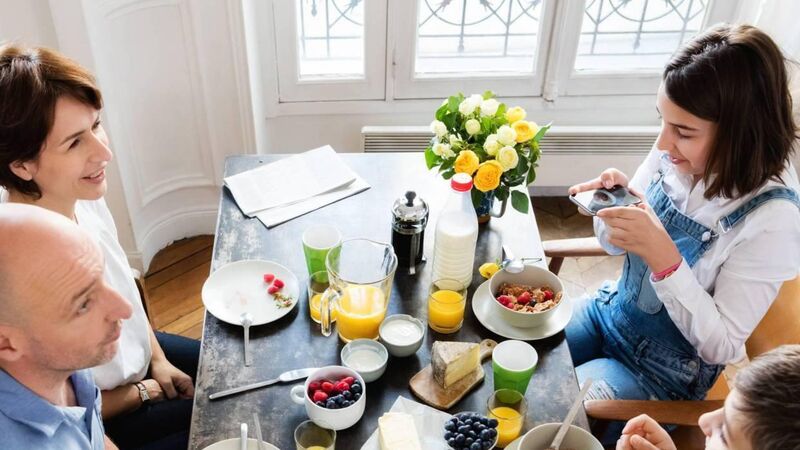The value of a mealtime and a kitchen table in modern world

As children go back to school and autumn routines set in, we need to value mealtimes together, says Áilín Quinlan.
See, there’s been a lot of talk in this house about putting in a new kitchen. One of those ergonomically designed, utterly sensible, and practical modern ones.
The kind where the hob is separate to two ovens and a warming drawer, or else you have a hob separate to an oven, a warming drawer and one of those Ninja air-fryers (the exact combination has not been decided upon just yet), and the ubiquitous microwave.
There will be good-quality worktops near the ovens for resting stuff on, some big free-standing cabinets, and a posh new sink.
But I’m cautious. I’m wary. I will not be rushed or pushed into anything because I love my old kitchen.
It is much-loved, well-used and, it cannot be denied, by now extremely well-worn.
Then someone threw the cat among the pigeons by suggesting we do away with the old oak kitchen table and chairs, which we bought second-hand in a massive used-Dutch-furniture warehouse somewhere near Washington Street back in the early ’90s (anyone remember those brilliant shops?) and which have never been changed, and to my mind, never would be changed.
But now, suddenly, all the talk was that we’d install some swanky island thing with a hob in the middle of it, and maybe a sink and some sort of by-the-by tall-stool seating arrangement at the end of it.
Those Christmases when we could have up to 10 people for dinner, my husband and son would lug in an enormous board of MDF from the shed to lay on top of the table, to allow for the extra settings. Every Christmas Eve, we prepared the vegetables, made the sauces, stuffings and desserts, washed the floor, and cleaned up so that the enormous board could be brought in from the shed.
First it had to be very carefully balanced on the table. Then it was covered with white cotton table-cloths and decorated to the best of my ability, with a special Christmas runner, gold candles and green wreaths - all of which, of course, had to come off again the very second the smallies rushed to their seats. But anyway.
Other memories: Homework. Artwork. Craftwork. Children’s birthday parties. Landmark family birthday, anniversary and retirement dinners. An emigration dinner with a dramatic cake featuring an airplane. Family meetings. Dramas. Confessions. Laughter. Tears. Tantrums. Shock, horror, hilarity.
There was the time one of my offspring, perched in the high-chair next to grandad, suddenly vomited, with great accuracy, all over gran-dad’s plate of dinner. There was the time of the mad house party, about which I will say nothing other than that we, the parents, were absent at the time and oblivious to the shenanigans, but at which, I learned years later, the guests used the table-edge to crack open the caps of their cider bottles.
My son was particularly proud of the fact that his gimlet-eyed father, who had re-varnished the table on more than one occasion since that outrageous shindig, had somehow never noticed the bottle-top scars.
Because over the years, and as a result of regular, long-standing use, the table has become as much part of the family as it is part of the furniture.
Eating around a kitchen table encourages communication. Eating your dinner in front of the TV or on a sofa with an ipad or a phone does not.
Yes, life is busy. Life has always been busy. And now, with the new school year just around the corner, the lives of many families are about to become a lot busier.
Research shows that about one-third of people believe their family is too busy to eat together. But if only those who feel they’re too busy to eat together knew what they’re missing out on!
Mealtimes around the table offer one of the few opportunities for spending time together and talking. Research shows that families who regularly sit and eat together have lower rates of depression and better family relationships.
Oddly enough, it seems, having regular family mealtimes is a stronger predictor of better academic performance - even stronger than doing homework.
Studies also show that teenagers who enjoy family meals at least five times a week are twice as likely to get A-grades in school as those in families which only eat together less than twice a week.
It also boosts their self-esteem, reduces the risk of developing eating disorders and, amazingly, apparently makes children four time less likely to engage in risky behaviours like abusing drugs and alcohol or smoking.
Families who enjoy mealtimes together, according to the research, also generally eat more healthy food. And, when the children become adults, they too tend to have healthier diets and lower rates of obesity.
But, of course, given the toxicity of modern living, all of this won’t happen automatically. You’ll have to take an unpopular stand and ban screens from the dinner table. You’ll have to batch cook and freeze dinners for the days when you’re too exhausted or too late in from work to peel vegetables. You’ll make extra-big stews or casseroles that will last in the pot over two days.
You’ll cook healthy balanced meals with lots of vegetables, fish, lean meat, potatoes with the skin on and brown rice.
And you will encourage your children to cook along with you, to set the table and help to clear up after dinner, instead of sitting around like little emperors playing games on their phones.
Make your table count. According to the research, it really is worth it in the end.







 App?
App?







